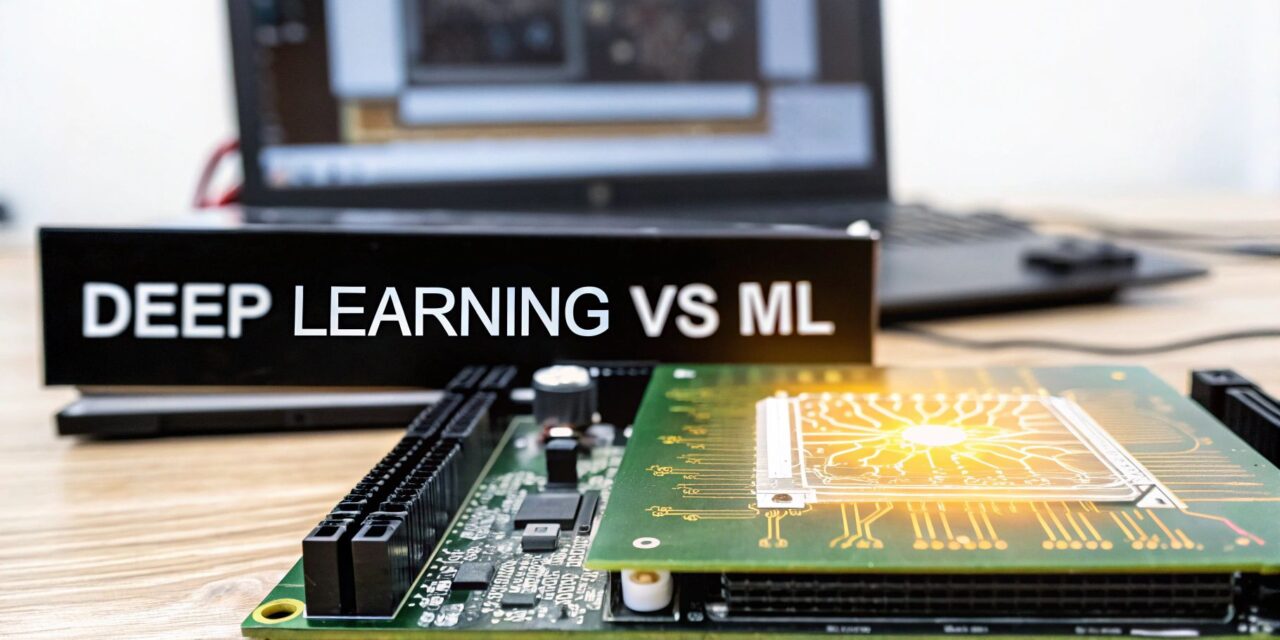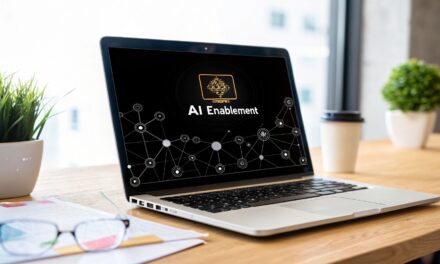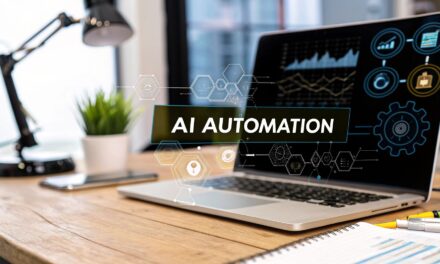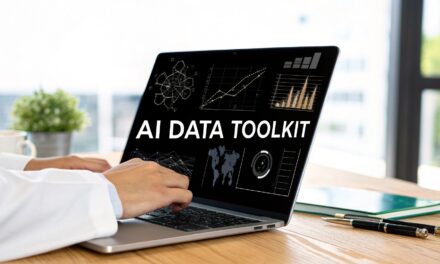The main difference between deep learning vs machine learning is that deep learning is a specialized, more advanced type of machine learning. The easiest way to picture it is like a set of Russian nesting dolls. Artificial Intelligence (AI) is the largest doll, the whole big idea. Inside it, you find Machine Learning (ML), a smaller doll that represents a specific way to build AI. And inside that is Deep Learning (DL), the smallest, most complex doll of them all.
Understanding the AI Family Tree
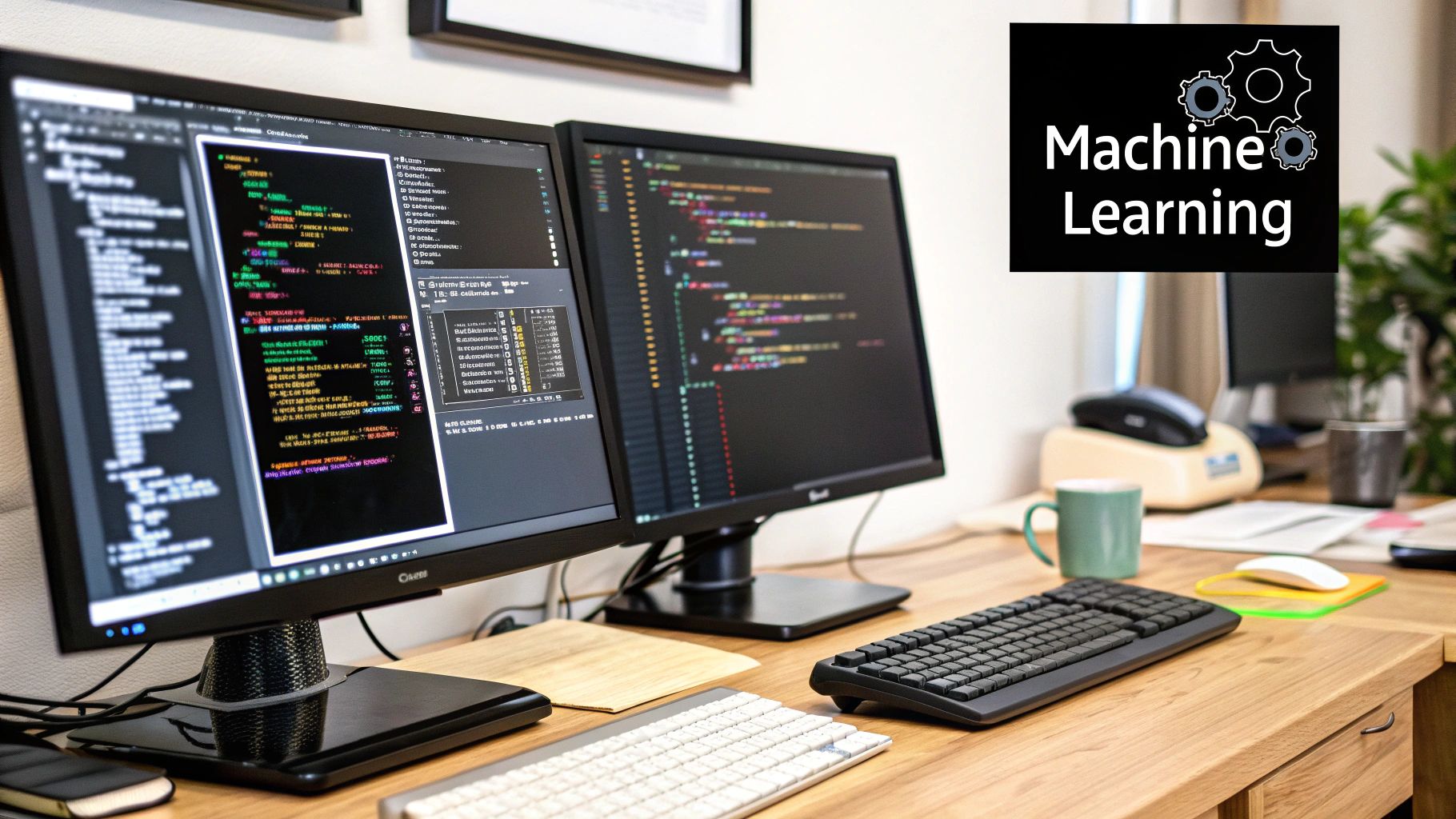
It's so easy to get lost in AI buzzwords. You probably hear "machine learning" and "deep learning" thrown around like they're the same thing, but they’re actually very different. Getting this distinction right is your first step to really understanding how today's AI works.
First up is Artificial Intelligence (AI). This is the big, exciting dream: building machines that can do things we'd consider "smart." It’s the giant umbrella covering everything else.
Then you have Machine Learning (ML), a huge part of AI. Instead of giving a computer a super-detailed list of rules for every single situation, ML lets the computer learn from data. You show it a ton of examples, and it figures out the patterns on its own to make future predictions.
Where Deep Learning Fits In
Deep learning is a specific kind of machine learning, but it takes this "learning from data" idea to a whole new level. It uses something called an artificial neural network, which is a complex structure loosely inspired by the human brain. These networks have many layers—that’s where the "deep" part comes from—allowing them to learn from enormous amounts of data in a much more sophisticated way.
As AI pioneer Andrew Ng puts it, "AI is the new electricity." This isn't just a catchy phrase; it perfectly captures how both machine learning and deep learning are becoming the foundational power source for countless innovations, just as electricity transformed society over a century ago.
The real magic of deep learning is that it can teach itself. A classic machine learning model might need a person to point out the important stuff—like telling it to look for eyes and a nose to identify a face. A deep learning model, however, can figure that out all by itself just by looking at the raw picture data.
Here's a simple breakdown of how they relate:
| Category | Artificial Intelligence (AI) | Machine Learning (ML) | Deep Learning (DL) |
|---|---|---|---|
| Scope | The big idea of creating intelligent machines. | A way to achieve AI by learning from data. | A special type of ML using deep neural networks. |
| Core Idea | Making machines think like humans. | Algorithms that get better with experience. | Self-learning from huge datasets using layered networks. |
How Machine Learning Works in the Real World
So, what does machine learning actually do? At its heart, it’s about showing a computer lots of examples and letting it figure things out. Instead of a developer writing rigid "if this happens, do that" instructions, the algorithm learns from experience.
Think of it like training a new puppy. You don't give it a rulebook for good behavior. You show it what to do, reward it when it gets it right (like sitting on command), and over time, it learns the pattern. An ML model does the same thing, but with data points instead of treats.
The Training Process in Action
This learning phase is called "training." A data scientist picks an algorithm—like a decision tree or a support vector machine—and feeds it a prepared dataset. The algorithm then adjusts its internal logic over and over, trying to find the best way to predict the outcomes in the training data. The final product is a trained "model" ready to make smart predictions on brand-new data.
A perfect, everyday example is your email’s spam filter.
The ML model behind your spam filter has seen millions of emails that people have already marked as "spam" or "not spam." From this, it learns what junk mail tends to look like.
What exactly is it looking for?
- Suspicious Keywords: Phrases like “You’ve won!” or “Urgent action required” are big red flags.
- Sender History: Is the email from someone in your contacts or a weird, random address?
- Strange Formatting: Think text in ALL CAPS, weird fonts, or way too many links.
- Attachment Types: An unexpected .exe file is a classic warning sign.
By analyzing all these clues across a giant dataset, the model builds a really good sense of what spam looks like. It’s not a simple checklist; it's calculating the probability that a new email is junk based on all these signals combined.
Ask any seasoned AI researcher, and they'll tell you that traditional ML shines when the problem is well-defined and the data is neatly structured. Spam filtering is a textbook case: the goal is clear (classify the email), and the features (words, sender, links) are easy to pull out and organize.
This is a key trait of traditional machine learning—it loves clean, structured data. A fascinating study on traffic prediction at an Italian tollbooth really proves this point. Researchers tested several ML models against a more complex deep learning model and found that an ML algorithm called XGBoost was more accurate at predicting traffic based on hourly records.
When it comes to deep learning vs machine learning, this shows that more complexity isn't always better. For many problems with organized, numerical data, a good old-fashioned ML model often wins the day.
Exploring the Power of Deep Learning
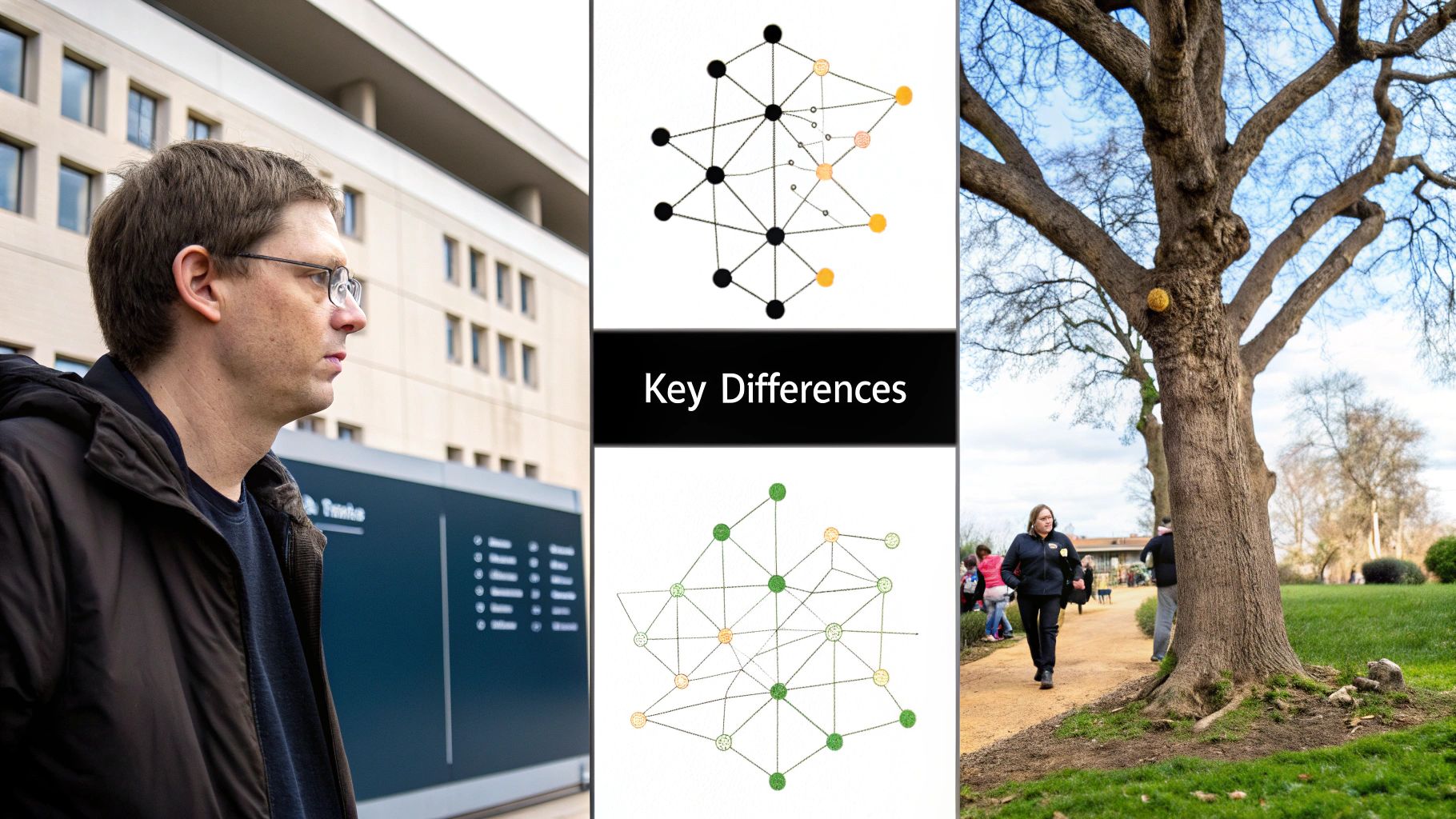
Now let's dive into the deeper and, let's be honest, more exciting world of deep learning (DL). If machine learning is like teaching a computer with clear examples, then deep learning is like giving it a mini-brain. This "brain" is an artificial neural network, built with tons of connected layers that process information in a way that’s loosely inspired by our own neurons.
It’s these deep, multi-layered networks that give DL models their incredible ability to find tiny, complex patterns hidden in giant piles of data. This is what really separates deep learning from machine learning, making it the perfect tool for tasks that feel more intuitive or abstract.
The Magic of Automatic Feature Extraction
The real game-changer in the deep learning vs machine learning debate is automatic feature extraction. In a normal ML project, a data scientist has to do a lot of work upfront. They have to manually create "features"—basically, telling the model what clues to look for, like flagging specific words for a spam filter.
Deep learning models figure this out on their own. You can feed them raw data, and as it passes through the network's layers, each layer learns to spot progressively more complex features, all without a human telling it what to do.
As AI expert Andrew Ng often points out, deep learning models really come alive with enormous amounts of data. The deep neural networks need a vast playground of examples to learn these intricate features from the ground up.
A classic example of this is a facial recognition system. Imagine trying to write code to identify a face from a bunch of pixels. It would be a nightmare! A deep learning model handles this almost effortlessly.
- Layer 1: The first layer might just learn to spot basic things like edges or bright spots.
- Layer 2: The next layer combines those edges to recognize more complex shapes, like an eye or the curve of a nose.
- Layer 3: Deeper in, another layer puts those parts together to understand the general structure of a face.
- Final Layer: By the end, the model can confidently identify a specific person.
This self-learning from raw data is exactly why deep learning is so good with messy, "unstructured" information like images, audio, and text. For a long time, people were skeptical of this approach, but it proved its worth in a huge way. The big moment was the 2012 ImageNet competition, where a deep neural network called AlexNet crushed the competition, cutting image recognition errors by an incredible 41% compared to the best ML models. That event kicked off a massive shift in AI. You can discover more about this historical shift in AI and the huge impact it had.
Comparing Key Operational Differences
Okay, we've covered the "what," so let's get practical. Choosing between machine learning and deep learning isn't just about theory; it comes down to what resources you have and the problem you need to solve. The differences in how they operate are huge and can easily make or break a project.
I like to compare it to choosing between a reliable pickup truck and a high-performance Formula 1 car. Sure, they're both vehicles, but their fuel needs, maintenance, and the types of tracks they excel on are worlds apart. The same goes for deep learning vs machine learning.
Data Requirements: The Thirst for Information
One of the biggest differences is how much data each one needs to work well. Traditional machine learning can do amazing things with smaller, well-organized datasets. It's the pickup truck—practical and efficient for everyday jobs without needing a giant fuel tank.
Deep learning, on the other hand, is incredibly data-hungry. Its complex neural networks need to see a massive number of examples to learn the subtle patterns needed for accurate predictions. Without a ton of data, a deep learning model can get confused or "overfit"—which means it just memorizes the training examples instead of actually learning the rules.
This isn't just a technical detail. Deep learning models often need thousands, or even millions, of labeled examples to train well, especially for things like image recognition. In contrast, traditional ML can get great results with much less. This is why some industry reports suggest that 70–80% of AI used in business today still relies on traditional machine learning, which has much lower data and cost demands. You can read more about these enterprise AI trends to see how companies are making these choices.
This infographic neatly sums up the main trade-offs.
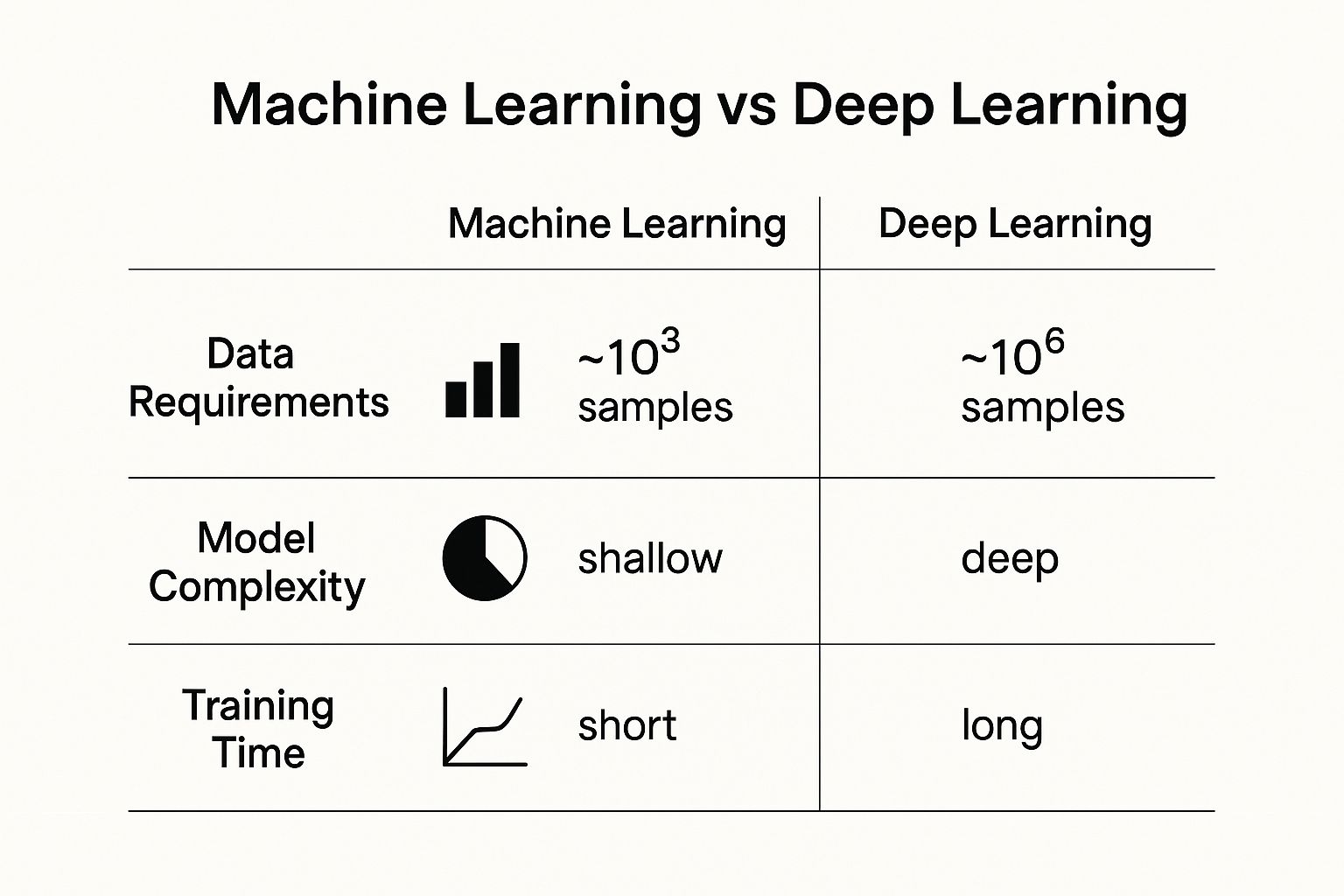
As you can see, deep learning's power comes at the price of needing a lot more data and time.
Hardware Dependencies: CPU vs. GPU
That massive appetite for data leads to another big difference: the computer hardware you need. Training a deep learning model involves a mind-boggling number of math calculations.
- Machine Learning (ML): Most traditional ML models run just fine on a standard computer processor, or CPU. They aren't as computationally heavy, so you can get started without investing in expensive, specialized hardware.
- Deep Learning (DL): Deep learning almost always requires a Graphics Processing Unit (GPU). GPUs were originally designed for video games and are amazing at handling thousands of calculations at the same time, which makes them perfect for training neural networks. Trying to train a deep learning model on a CPU would be painfully slow—we're talking weeks or months instead of hours or days.
A common expert opinion is that your choice of hardware is one of the first practical tests of whether your project is suited for deep learning. If you don't have access to or a budget for powerful GPUs, sticking with traditional machine learning is often the smarter, more realistic path.
Feature Engineering: Human Effort vs. Automation
Finally, let's talk about the human side of things. As we mentioned earlier, one of the best things about deep learning is its ability to do automatic feature extraction.
In a traditional machine learning project, a data scientist spends a huge amount of time on feature engineering. This is a manual process where they select, tweak, and create the right input variables (or "features") for the model to learn from. It takes a lot of expertise and trial and error.
A deep learning model, with its layered network, automates this whole process. You can just feed it raw data—like the raw pixels of an image—and the network will figure out the important features all on its own. This saves a ton of human effort and lets the model find patterns a person might never have even thought to look for.
Machine Learning vs Deep Learning At a Glance
To wrap up these key differences, here's a quick cheat sheet. It gives you a simple side-by-side comparison of how machine learning and deep learning stack up in the real world.
| Aspect | Machine Learning (ML) | Deep Learning (DL) |
|---|---|---|
| Data Volume | Works well with small to medium datasets. | Needs massive datasets (big data). |
| Hardware | Can run efficiently on a standard CPU. | Needs powerful GPUs for effective training. |
| Feature Engineering | Requires manual, human-driven feature selection. | Automates feature extraction through its neural network. |
| Training Time | Relatively fast, from minutes to hours. | Very slow, can take days or even weeks. |
This table should help you figure out which path might be a better fit based on the data, hardware, and time you have available.
Choosing the Right Tool for the Job
So, how do you decide which one to use? When looking at deep learning vs machine learning, the best choice isn't about which one is "smarter." It's about picking the right tool for your specific project. This decision really comes down to three things: your data, how complex your problem is, and the resources you have.
I like to think of it as choosing between a great family doctor and a world-class brain surgeon. For a routine check-up, your family doctor is perfect—they're efficient, knowledgeable, and get the job done. But for a rare, complex brain operation, you absolutely need the specialist. Machine learning is your trusted doctor; deep learning is that amazing surgeon.
When to Use Traditional Machine Learning
Traditional machine learning is the workhorse of the AI world. It's fantastic in situations where you have structured, labeled data—the kind of stuff you'd find in a nice, neat spreadsheet or database. If your problem has clear inputs and a straightforward goal, ML is almost always the more practical and affordable solution.
It's the top choice for a huge number of business tasks. For instance, imagine you run an online store and want to predict which customers might stop buying from you, a problem called customer churn.
You probably have access to valuable, structured data like:
- Purchase History: How often a customer buys and how much they spend.
- Website Activity: The last time they logged in or how long they browsed.
- Customer Support Tickets: How many times they've contacted you for help.
An ML model can look at this organized data, spot the patterns that lead to churn, and flag at-risk customers with surprisingly good accuracy. Better yet, it's relatively quick to set up and doesn't require a supercomputer to run.
Another classic example is credit card fraud detection. A bank can train an ML model on millions of past transactions, teaching it to spot the tiny, subtle signs of fraud. Since the data (transaction amount, location, time, etc.) is highly structured, a model like a random forest or gradient boosting machine can deliver great results quickly and efficiently.
For many business leaders I've spoken with, the interpretability of machine learning is a huge plus. They want to understand why the model made a certain prediction—a feature that’s much harder to get from the 'black box' nature of deep learning.
When to Unleash the Power of Deep Learning
Deep learning is your go-to when the problem is incredibly complex and the data is a messy, unstructured soup. This is where you call in the specialist surgeon. If your task involves perception, creativity, or understanding subtle context from raw data like images, audio, or text, deep learning is often the only tool that can do the job.
Think about the explosion of AI-generated art. Tools like Midjourney or DALL-E don't work by following simple rules. They use deep learning models that have been trained on billions of images from the internet. The model learns abstract ideas like artistic styles, objects, and moods, which allows it to create brand-new images from a simple text prompt. This is something traditional ML just can't do.
Voice assistants like Siri and Alexa are another perfect example. Understanding human language is messy and full of quirks. A deep learning model can process the sequence of words in your sentence, understand the context, and give you a helpful response. It learns the complex patterns of language on its own, a task that would be impossible to code by hand.
And, of course, there are self-driving cars. For a car to drive in the real world, it has to understand a constant stream of visual information from cameras. Deep learning models, especially Convolutional Neural Networks (CNNs), are crucial for this. They can identify pedestrians, read traffic signs, and understand road lanes in real-time by processing raw pixel data—a level of perception that is truly at the cutting edge of AI.
Choosing the right tool is a strategic decision. If you have organized data and a clear problem, machine learning is a powerful and efficient solution. But if you’re tackling a challenge that needs something closer to human perception with huge, messy datasets, the amazing capabilities of deep learning are what you need.
Making Your Final Decision
So, when it comes to deep learning and machine learning, how do you actually choose? It’s not about which one is "better" overall. It's about picking the right tool for the job you have right now, with the resources and data you can actually get your hands on. The flashiest, most complex solution isn't always the best one.
To cut through the hype, just ask yourself a few simple questions. Your answers will point you in the right direction and help you put your time and money where they'll make the biggest impact.
Your Go-To Checklist
Before you start a project, run through these four key questions.
-
How much clean, labeled data do I actually have?
If your dataset is organized and on the smaller side—think hundreds or maybe a few thousand rows in a spreadsheet—a classic machine learning model is your best friend. But if you're sitting on a massive pile of data, like millions of images or text files, then deep learning is where the real power is. -
What’s my budget for high-performance computers?
Standard machine learning models can often be trained on a good laptop CPU. Deep learning is a different story; it pretty much needs the power of GPUs. That can be a serious investment, so you have to factor in that cost from the very beginning. -
Is my problem complex enough to need deep learning?
For straightforward tasks like predicting customer churn from their purchase history, traditional ML is fantastic. But if you’re trying to understand the nuances of human speech, find a specific person in a busy video, or generate creative poetry, you’ll need the sophisticated power of a deep neural network. -
How important is it that I can explain the model's decisions?
Many machine learning models are "white box," meaning you can look inside and understand their logic. Deep learning models are more like a "black box"—they give amazing results, but figuring out the exact why can be nearly impossible. If you need to explain your model's decisions for compliance or to build trust, this is a huge factor.
The most important takeaway is this: the best choice is always situational. Don't get caught up in the deep learning hype if a simpler, more efficient machine learning model can solve your problem perfectly well and stay within your budget.
Ultimately, being honest about your answers here will give you a clear path forward. By basing your choice on the practical realities of your project, you'll be set up to pick the right AI tool for the right job.
Frequently Asked Questions
As you dive deeper into AI, you're bound to have more questions, especially when trying to figure out where machine learning stops and deep learning starts. Let's tackle some of the most common questions I hear from people who are just getting started.
Can I Use Deep Learning for a Small Project?
You technically can, but it’s almost always a bad idea. Deep learning models are incredibly data-hungry; they need massive datasets to learn properly and avoid a common problem called "overfitting."
Overfitting happens when a model gets so good at seeing the training data that it just memorizes it. When you show it something new, it fails because it never learned the general patterns. Think of it like a student who memorizes the answers to a practice test but can't solve slightly different problems on the real exam.
So, if you're building a simple app to predict house prices in your town with only a few hundred examples, a classic machine learning model will be your best bet. It’s more practical, less demanding, and will likely give you a much more reliable result.
Is Machine Learning Becoming Obsolete?
Not a chance. Machine learning is still the workhorse for a huge number of business problems, especially anything involving structured data—the kind you find in spreadsheets and databases. It's usually faster to train, needs less computing power, and is much easier to explain.
A common piece of advice from seasoned data scientists is that for most business analytics tasks—like forecasting sales or segmenting customers—traditional machine learning is not only sufficient but preferable. Its models are explainable, which is a massive plus when you need to justify decisions to stakeholders.
Many of the AI tools you use every day, like your email spam filter or the product recommendations on Amazon, run on proven machine learning models. The field is as important and active as ever.
Which One Is Easier to Learn for a Beginner?
Machine learning is definitely the better starting point. The core ideas are more straightforward, the math is less intense, and you can get real results without needing a supercomputer or tons of data. It gives you a solid foundation in the key AI principles that you'll need no matter what.
Deep learning, on the other hand, is a much steeper climb. It brings in advanced topics like neural network architectures and requires a pretty good handle on linear algebra and calculus. It's an incredible field, but most experts agree you should get comfortable with machine learning first. When it comes to the deep learning vs machine learning path for newcomers, ML is the clear on-ramp.
At YourAI2Day, our goal is to cut through the jargon and give you the knowledge you need to make confident decisions. To keep learning about the latest in artificial intelligence, check out more of our resources at https://www.yourai2day.com.

